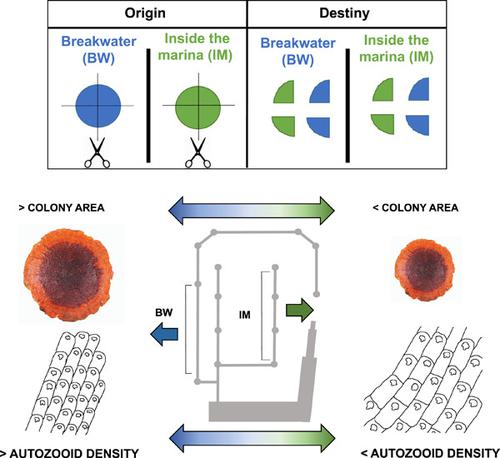当前位置:
X-MOL 学术
›
J. Exp. Zool. B Mol. Dev. Evol.
›
论文详情
Our official English website, www.x-mol.net, welcomes your
feedback! (Note: you will need to create a separate account there.)
Artificial habitats induce plasticity in colonies of the marine bryozoan Schizoporella errata
Journal of Experimental Zoology-B: Molecular and Developmental Evolution ( IF 1.8 ) Pub Date : 2020-04-14 , DOI: 10.1002/jez.b.22942 Gustavo M Dias 1 , Felipe S Dutra 1 , Rafael C Duarte 1
Journal of Experimental Zoology-B: Molecular and Developmental Evolution ( IF 1.8 ) Pub Date : 2020-04-14 , DOI: 10.1002/jez.b.22942 Gustavo M Dias 1 , Felipe S Dutra 1 , Rafael C Duarte 1
Affiliation

|
Modular organization provides flexibility for colonial animals to deal with variable and unpredictable environmental conditions since each module has specific tasks within the colony, such as feeding, defending or reproducing. Depending on the selecting pressures, sessile organisms may phenotypically adjust the morphology of each module or modify their density, increasing individual fitness. Here we used the marine bryozoan Schizoporella errata (Cheilostomata, Schizoporellidae) to test how the divergent conditions between two artificial habitats, the location inside a marina (IM) and the external wall of the breakwater (BW), affect colony size and the density of the distinct modules. The density of avicularia and ovicells, modules related to defense and reproduction, respectively, did not differ between habitats. However, colonies growing in the turbulent waters of BW were, in general, larger and had higher density of feeding autozooids than those at IM. Reciprocal transplants of bryozoan clones indicated that trait variation is genotype‐dependent but varies according to the environmental conditions at the assigned location. The occurrence of larger colonies with more zooids in BW is probably linked to the easier feeding opportunity offered by the small diffusive boundary layer around the colony at this location. Since in colonial polymorphic organisms each module (zooid) performs a specific function, the phenotypic response is not uniform across colonies, affecting only those modules that are susceptible to variations in the main selective pressures. Understanding the importance of colony‐level plasticity is relevant to predict how modularity will contribute to organisms to deal with human‐induced environmental changes in coastal habitats.
中文翻译:

人工栖息地诱导海洋苔藓虫 Schizoporella errata 群落的可塑性
模块化组织为殖民地动物提供了应对可变和不可预测的环境条件的灵活性,因为每个模块在殖民地内都有特定的任务,例如喂养、防御或繁殖。根据选择压力,固着生物可能会在表型上调整每个模块的形态或修改它们的密度,从而增加个体适应性。在这里,我们使用了海洋苔藓虫Schizoporella 勘误表(Cheilostomata, Schizoporellidae) 来测试两个人工栖息地之间的不同条件,即码头内的位置 (IM) 和防波堤 (BW) 的外墙,如何影响菌落大小和不同模块的密度。鸟类和卵细胞的密度,分别与防御和繁殖相关的模块,在栖息地之间没有差异。然而,在 BW 的湍流水域中生长的菌落通常比 IM 的菌落更大,并且具有更高的进食自体动物密度。苔藓虫克隆的相互移植表明性状变异是基因型依赖性的,但根据指定位置的环境条件而变化。在 BW 中出现具有更多动物的较大菌落可能与该位置菌落周围小扩散边界层提供的更容易进食机会有关。由于在群落多态生物中,每个模块(zooid)都执行特定的功能,因此菌落之间的表型反应并不统一,仅影响那些易受主要选择压力变化影响的模块。了解群体水平可塑性的重要性与预测模块化将如何促进生物体应对沿海栖息地人为引起的环境变化有关。仅影响那些易受主要选择压力变化影响的模块。了解群体水平可塑性的重要性与预测模块化将如何促进生物体应对沿海栖息地人为引起的环境变化有关。仅影响那些易受主要选择压力变化影响的模块。了解群体水平可塑性的重要性与预测模块化将如何促进生物体应对沿海栖息地人为引起的环境变化有关。
更新日期:2020-04-14
中文翻译:

人工栖息地诱导海洋苔藓虫 Schizoporella errata 群落的可塑性
模块化组织为殖民地动物提供了应对可变和不可预测的环境条件的灵活性,因为每个模块在殖民地内都有特定的任务,例如喂养、防御或繁殖。根据选择压力,固着生物可能会在表型上调整每个模块的形态或修改它们的密度,从而增加个体适应性。在这里,我们使用了海洋苔藓虫Schizoporella 勘误表(Cheilostomata, Schizoporellidae) 来测试两个人工栖息地之间的不同条件,即码头内的位置 (IM) 和防波堤 (BW) 的外墙,如何影响菌落大小和不同模块的密度。鸟类和卵细胞的密度,分别与防御和繁殖相关的模块,在栖息地之间没有差异。然而,在 BW 的湍流水域中生长的菌落通常比 IM 的菌落更大,并且具有更高的进食自体动物密度。苔藓虫克隆的相互移植表明性状变异是基因型依赖性的,但根据指定位置的环境条件而变化。在 BW 中出现具有更多动物的较大菌落可能与该位置菌落周围小扩散边界层提供的更容易进食机会有关。由于在群落多态生物中,每个模块(zooid)都执行特定的功能,因此菌落之间的表型反应并不统一,仅影响那些易受主要选择压力变化影响的模块。了解群体水平可塑性的重要性与预测模块化将如何促进生物体应对沿海栖息地人为引起的环境变化有关。仅影响那些易受主要选择压力变化影响的模块。了解群体水平可塑性的重要性与预测模块化将如何促进生物体应对沿海栖息地人为引起的环境变化有关。仅影响那些易受主要选择压力变化影响的模块。了解群体水平可塑性的重要性与预测模块化将如何促进生物体应对沿海栖息地人为引起的环境变化有关。











































 京公网安备 11010802027423号
京公网安备 11010802027423号